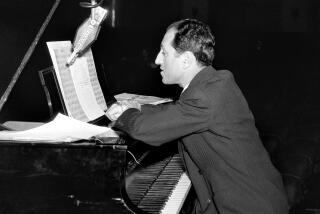Hersch Goes ‘Beyond’ Gershwin With Impeccable Virtuosity
- Share via
Gershwin took second place to “Beyond” again Sunday night at the Skirball Cultural Center’s “Gershwin and Beyond” program. Pianist Fred Hersch’s repertoire, like Brad Mehldau’s in a concert two weeks ago in the same venue, offered only a few Gershwin numbers--two, in fact: “Embraceable You” and “I Loves You Porgy.” Fortunately, Hersch is such a diversified artist that the material he presented in the balance of his program was compelling enough to more than compensate for the shift in emphasis.
There are many ways to conduct an improvisationally based solo piano performance, ranging from classic stride and ragtime to right-hand-oriented bebop, New Age meandering and jazz/classical stylistic blendings (with numerous other stops in between). Hersch took a more personal tack, using his classically trained virtuosity in several ways: to provide note-dense settings as melodic accompaniment; as the confident foundation for the re-composing of familiar themes; as an engine to drive his briskly swinging jazz passages.
What was most engaging about his interpretations was the lyrical, almost vocalized touch he brought to his lines, spinning out melodies with a simplicity based upon a tremendously subtle use of phrasing, of finding the dramatic moments in the pauses between melodic fragments.
This was especially apparent in several ballads--notably a stunning rendering of Cole Porter’s “So in Love” that transformed it into a virtual operatic aria, a lovely reading of pianist Russ Freeman’s unjustifiably obscure “The Wind,” and thoughtful versions of Hoagy Carmichael’s “The Nearness of You” and Antonio Carlos Jobim’s “O Grande Amor.”
The centerpiece of Hersch’s program, however, was an original, six-movement suite that will be a part of his next album, scheduled for release early next year. The sections were concisely titled--”Aria,” “Ballad,” “Tango,” “Duet,” “Lullaby” and “Waltz.” And, aside from the somewhat mysteriously labeled “Duet,” Hersch’s combination of writing and improvisation found the heart of each form, especially the spirited “Tango.”
Like the balance of the program, it was the product of a virtuosic technique at the service of a gifted musical imagination.
More to Read
The biggest entertainment stories
Get our big stories about Hollywood, film, television, music, arts, culture and more right in your inbox as soon as they publish.
You may occasionally receive promotional content from the Los Angeles Times.










